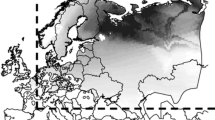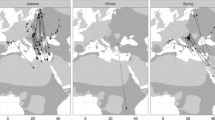Abstract
Analysis of ring recovery data for Short-eared Owls Asio flammeus spanning 96 years, 1912–2007, identified spatial and temporal differences in migration patterns. Birds with breeding areas or natal origins in the Boreal (principally Fenno-Scandinavia) and Continental (principally central Europe) regions tended to move the greatest distances. Although birds from the North Sea littoral and Britain tended to move shorter distances, recoveries included far eastern Europe (Russia), the Mediterranean and North Africa. Recovery distances showed a marked quadratic relationship with time, generally increasing through to the 1960s and 1970s and then subsequently declining, with the apparent turning point being latest for birds from the Boreal region and upland Britain (areas that retain the strongest populations). Temporal changes in recovery distances appear to be positively related to breeding population density (at least in some areas), but vagaries associated with knowledge of the past and current status of Short-eared Owls in many areas adds difficulty to assessing the validity of such an association. Movements of birds between different breeding seasons suggests considerable potential for connectivity between areas; however, a tendency for reducing distances for such movements since the mid-twentieth century might limit the viability of some ‘populations’ in more southern and fragmented parts of their range.
Zusammenfassung
Veränderungen im Zugmuster der Sumpfohreule Asio flammeus in Europa: eine Auswertung von Ring-Wiederfunden
Die Auswertung von Ringwiederfunddaten der Sumpfohreule Asio flammeus über einen Zeitraum von 96 Jahren hinweg, von 1912–2007, ergab räumliche und zeitliche Unterschiede in den Zugmustern. Vögel mit Brutgebieten oder Geburtsorten in borealen (im wesentlichen Fennoskandien) und kontinentalen (überwiegend Mitteleuropa) Regionen zeigten tendenziell die weitesten Zugwege. Wenngleich Vögel von der Nordseeküste und aus Großbritannien eher kürzere Strecken zurücklegten, beinhalteten ihre Wiederfunde Osteuropa (Russland), den Mittelmeerraum und Nordafrika. Die Wiederfunddistanzen zeigten eine auffällig quadratische Beziehung mit der Zeit mit einer generellen Zunahme in den 1960er und 1970er Jahren und einer darauf folgenden Abnahme. Zeitlich am kürzesten zurück lag dabei der Wendepunkt für Vögel der borealen Regionen und des britischen Hochlands (Gegenden die die stärksten Populationen beherbergen). Zeitliche Veränderungen in den Wiederfunddistanzen sind offensichtlich (zumindest in einigen Gegenden) positiv mit der Dichte der Brutpopulationen korreliert, aber Unsicherheiten bezüglich unserer Kenntnisse des früheren und gegenwärtigen Status der Sumpfohreulen in vielen Gegenden machen die richtige Interpretation der Bedeutung dieses Zusammenhangs schwierig. Ortsveränderungen von Vögeln zwischen verschiedenen Brutsaisons deuten auf ein beachtliches Potential von Konnektivität zwischen Brutgebieten hin, allerdings könnte die Verkürzungstendenz in diesen Ortsveränderungen seit Mitte des zwanzigsten Jahrhunderts die Überlebensfähigkeit einiger “Populationen” in südlicheren und fragmentierteren Teilen des Verbreitungsgebiets limitieren.






Similar content being viewed by others
References
Angelstam P, Runfors O, Mikusinski G, Seiler C (2000) Long-term dynamics of three types of black grouse habitat in the centre and at the edge of the distribution range in Sweden 1850–2000. Cah Ethol 20:165–190
BirdLife International (2004) Birds in Europe: population estimates, trends and conservation status. BirdLife International, Cambridge
Brommer JE, Pietiäinen H, Ahola K, Karell P, Karstinen T, Kolunen H (2010) The return of the vole cycle in southern Finland refutes the generality of the loss of cycles through ‘climatic forcing’. Glob Change Biol 16:577–586
Brown A, Grice P (2005) Birds in England. Poyser, London
Burfield IJ (2008) The conservation status and trends of raptors and owls in Europe. Ambio 37:401–407
Calladine J, Garner G, Wernham C, Buxton N (2010) Variation in the diurnal activity of breeding short-eared owls Asio flammeus: implications for their survey and monitoring. Bird Study 57:89–99
del Hoyo J, Elliot A, Sargatal J (1999) Handbook of birds of the world, vol 5. Lynx, Barcelona
Du Feu CR, Joys AC, Clark JA, Fiedler W, Downie IS, van Noordwijk AJ, Spina F, Wassenaar R, Baillie SR (2009) EURING data geographical index. (http://www.euring.org/edb)
ESRI (2006) ArcGIS v.9.2. Redlands, CA
Gibbons DW, Reid JB, Chapman RA (1993) The new atlas of breeding birds in Britain and Ireland: 1988–1991. Poyser, London
Glue D, Korpimäki E (1997) Short-eared owl. In: Hagermeijer EJM, Blair MJ (eds) The EBCC Atlas of European breeding birds: their distribution and abundance. oPoyser, London, pp 418–419
Goddard TR (1935) A census of short-eared owls (Asio f. flammeus) at Newcastleton, Roxburghshire, 1934. J Anim Ecol 4:113–118
Greenwood JJD, Crick HQP, Bainbridge IP (2003) Numbers and international importance of raptors and owls in Britain and Ireland. In: Thompson DBA, Redpath SM, Fielding AH, Marquiss M, Galbraith CA (eds) Birds of prey in a changing environment. The Stationary Office, Edinburgh, pp 25–50
Hörnfeldt B, Hipkiss T, Eklund U (2005) Fading out vole and predator cycles? Proc R Soc Lond 272:2045–2049
IPCC (2007) Climate change 2007: synthesis report. Contribution of working groups I, II and III to the fourth assessment. In: Pachauri RK, Reisinger A (eds). Report of the Intergovernmental Panel on Climate Change. IPCC, Geneva
Kjellén N, Roos G (2000) Population trends in Swedish raptors demonstrated by migration counts at Falsterbo, Sweden. Bird Study 47:195–211
Knowler JT (2007) Short-eared Owl. In: Forrester RW, Andrews IJ, McInerny CJ, Murray RD, McGowan RY, Zonfrillo B, Betts MW, Jardine DC, Grundy DS (eds) The birds of Scotland. The Scottish Ornithologists’ Club, Aberlady, pp 925–928
Korpimäki E (1994) Rapid or delayed tracking of multi-annual vole cycles by avian predators? J Anim Ecol 63:619–628
Korpimäki E, Norrdahl K (1991) Numerical and functional responses of kestrels, short-eared owls, and long-eared owls to vole densities. Ecology 72:814–826
Lehikoinen A, Ranta E, Pietiäinen H, Byholm P, Saurola P, Valkama J, Huitu O, Henttonen H, Korpimäki E (2011) The impact of climate and cyclic food abundance on the timing of breeding and brood size in four boreal owl species. Oecologia 165:349–355
Linder P, Östlund L (1998) Structural changes in three mid-boreal Swedish forest landscapes, 1885–1996. Biol Conserv 85:9–19
McCulloch MN, Tucker GM, Baillie SR (1992) The hunting of migratory birds: a ringing recovery analysis. Ibis 134(suppl):55–65
Michelat D (1997) La nidification du Hibou des marais Asio flammeus en France en 1993. Ornithos 4:35–40
Newton I (2006) Advances in the study of irruptive migration. Ardea 94:433–460
Petty SJ, Lambin X, Sherratt TN, Thomas CJ, Mackinnon JL, Coles CF, Davison M, Little B (2000) Spatial synchrony in field vole Microtus agrestis abundance in a coniferous forest in northern England: the role of vole-eating raptors. J Appl Ecol 37:136–147
Poulin RG, Wellicome TI, Todd LD (2001) Synchronous and delayed numerical responses of a predatory bird community to a vole outbreak on the Canadian prairies. J Raptor Res 35:288–295
Reynolds P, Gorman ML (1999) The timing of hunting in short-eared owls (Asio flammeus) in relation to the activity patterns of Orkney voles (Microtus arvalis orcadensis). J Zool Lond 247:371–379
Rich TD, Beardmore CJ, Berlanga H, Blancher PJ, Bradstreet MSW, Butcher GS, Demarest DW, Dunn EH, Hunter WC, Inigo-Elias EE, Kennedy JA, Martel AM, Pujabi AO, Rosenberg KV, Rustay CM, Wendt JS, Will TC (2004) Partners in flight North American landbird conservation plan. Cornell Laboratory of Ornithology, Ithaca
Roberts JL, Bowman N (1986) Diet and ecology of short-eared owls Asio flammeus breeding on heather moor. Bird Study 33:12–17
Robinson RA, Grantham MJ, Clark JA (2009) Declining rates of ring recovery in British birds. Ringing Migr 24:266–272
SAS Institute (2008) SAS v.9.2, Cary, NC
Saurola P (2009) Bad news and good news: population changes in Finnish owls during 1982–2007. Ardea 97:469–782
Shaw G (1995) Habitat selection by short-eared owls Asio flammeus in young coniferous forests. Bird Study 42:158–164
Siriwardena GM, Wernham CV, Baillie SR (2004) Quantifying variation in migratory strategies using ring-recoveries. Anim Biodivers Conserv 27:299–317
Village A (1987) Numbers, territory-size and turnover of short-eared owls Asio flammeus in relation to vole abundance. Ornis Scand 18:198–204
Wernham CV, Siriwardena GM (2002) Analysis and interpretation of ring-recovery data. In: Wernham CV, Toms MP, Marchant JH, Clark JA, Siriwardena GM, Baillie SR (eds) The migration atlas: movements of the birds of Britain and Ireland. Poyser, London, pp 44–69
Acknowledgments
We are grateful to the European Union for Bird Ringing (EURING) which made the recovery data available through the EURING data bank, and to the many ringers and ringing scheme staff who have gathered and prepared the data. Staffan Roos undertook some initial sorting of the data.
Author information
Authors and Affiliations
Corresponding author
Additional information
Communicated by F. Bairlein.
Rights and permissions
About this article
Cite this article
Calladine, J., du Feu, C. & du Feu, R. Changing migration patterns of the Short-eared Owl Asio flammeus in Europe: an analysis of ringing recoveries. J Ornithol 153, 691–698 (2012). https://doi.org/10.1007/s10336-011-0786-y
Received:
Revised:
Accepted:
Published:
Issue Date:
DOI: https://doi.org/10.1007/s10336-011-0786-y




